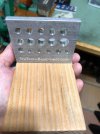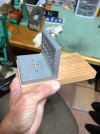No, the affects of runout do not manifest as linear. Given this, for as many who think runout matters, their are those who don't. An abstract.
Runout can matter, but not for the reason written about in gun rags, and most books. These describe runout as a concentricity(misnomer for eccentricity) issue, causing chambered bullets to point off-axis with the bore, causing degraded engraving and release.
That's dead wrong, and easily proven so.
The truth is that runout (TIR)(not eccentricity) matters only when exceeding chamber clearances for it.
This, causing chambered pressure points, affecting barrel vibrations. If you were to press against your barrel at the chamber in the middle of a group, you could simulate this, likely seeing thrown shots.
To manage TIR, and stay clear of this, you should know your chamber clearances.
Just keep your TIR within this, anywhere.
It's not just necks, or bullets. It's the entire cartridge.
The root cause of runout is sizing of thickness variance. More of either = more TIR.


